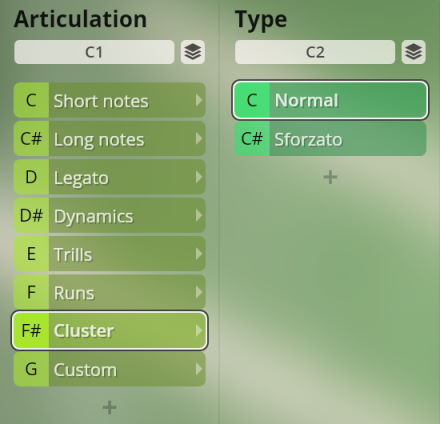SYNCHRON-ized Single Woodwinds Package
Introduction
Welcome to the Vienna Symphonic Library’s series of Synchron Instruments! The single instruments which together make the SYNCHRON-ized Single Woodwinds Package complement those contained in SYNCHRON-ized Woodwinds, and provide you not only with some instrumental rarities, but also with 3-player ensembles of flutes, oboes, clarinets, and bassoons. This document will provide you with the information you need to use the Library with our Vienna Synchron Player.
For creating these instruments, our sound editors went back to the raw, unprocessed sample data of the Collections Woodwinds I, Woodwinds II, and Special Woodwinds. The original recordings were completely reedited and re-mastered in order to achieve an all-new, modern sound that excels in terms of aesthetics, playability and realism, and that is optimized for use alongside the Synchron Series instruments.
About Presets
The library offers three basic Preset types for every instrument in their respective folders “Velocity”, marked “VelXF” and “VelXF sus”. In the regular “Velocity” presets, note volume is controlled by keystroke velocity just like a piano. In “VelXF” Presets, all articulations have velocity crossfading activated so that you can control dynamics with MIDI controller CC1, the modwheel. In “VelXF sus” Presets, however, velocity crossfading is only activated for long notes, while the dynamics of short notes are controlled by keystroke velocity, thus facilitating phrasing. Velocity crossfading can be enabled or disabled by clicking its on/off symbol in the Synchron Player's Perform tab.
Sound Categories
The Presets of each instrument are subdivided into several Articulation categories (depending on the instrument) plus a “Custom” slot ready for your own creations:
- Short notes
- Long notes
- Legato
- Dynamics
- Flutter tonguing, trills, fast repetitions
- Runs (Flute ensemble only)
- Clusters (ensembles)
Within these Articulation categories, you can select a Type (if applicable), e.g., short or medium portato, and for some of the types there are additional options available, such as marcato or vibrato type control.
Mixer Presets
For the SYNCHRON-ized Libraries, our software developers added a specifically designed convolution reverb derived from Vienna MIR Pro to the Synchron Player, featuring the outstanding and unique ambience of the 540 m2 (5,813 sq.ft.) main hall of Synchron Stage Vienna. The perfectly engineered reverberation and placement presets combine customized impulse responses with expertly crafted reverb settings for each instrument. By adding the ambience of Synchron Stage Vienna’s Stage A to the dry samples in real-time, SYNCHRON-ized instruments blend perfectly with any other product of our Synchron Series.
For each instrument, there are 8 Mixer Presets that depict different recording situations: Close, Classic, Wide, Distant, Ambient, Short/Long Reverb without convolution, and MIR Uncompressed for use with Vienna MIR.
About Patches
Patches can be used to build your own custom Presets and adapt the Synchron Libraries to your specific requirements. For further information on constructing Presets, please see the Synchron Player manual.
About Pitch
For designating pitch, the Vienna Symphonic Library uses International Pitch Notation (IPN), which was agreed upon internationally under the auspices of the Acoustical Society of America. In this system the international standard of A=440 Hz is called A4 and middle C is C4. All pitches are written as capital letters, their respective octave being indicated by a number next to it. The lowest C on the piano is C1 (the A below that is A0), etc.
The Synchron Player software allows you to set middle C to C3, C4, or C5 according to your preference. Selecting another setting than C4 will of course also change the play ranges and keyswitches accordingly.
Synchron Player Presets
The instrument Presets comprise all recorded Patches in articulation groups, which again contain types of the respective articulation, with further options if available. The general structure was modeled after our other Synchron Collections, making it easy to switch or combine instruments without major adaptations.
Articulations are disabled by default. Enabling an articulation means that all the types contained will be activated, too, so if you happen to be short of RAM it is advisable only to activate what you really need (you can always add more types later).
By default the keyswitches for articulations are mapped starting from C1 (for Middle C = C4) for higher instruments, and from C6 for bass instruments. For the available types, the keyswitches start from C2 for high instruments, and from C7 for low ones.
Additional options within articulations or types are offered by the Dimension Controllers. The controller function is indicated by the respective caption, as of course it may take on different tasks as needed.
Apart from the regular articulations, every instrument also features one called Custom that does not contain any samples. It provides 6 slots ready for you to configure presets of your own.
Alto flute
- Articulation switches: C1–F1
- Type switches: starting at C2
Short notes
Staccato, short portato, medium portato with and without vibrato, as well as legato, portato, and staccato repetitions.
Use Dim.Ctrl/B (CC4) to crossfade between medium portato without and with vibrato.
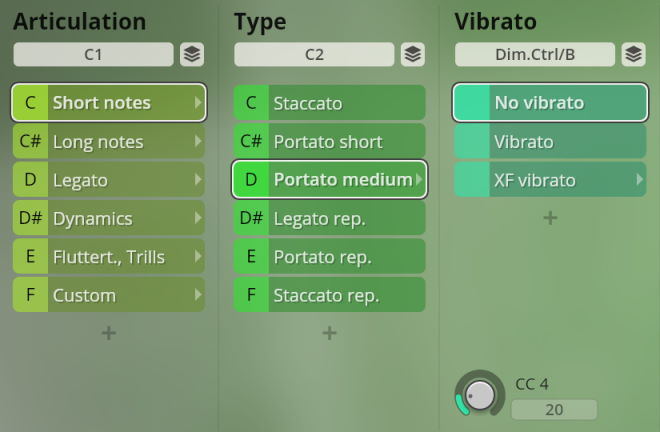
Long notes
Sustained notes, normal and marcato, without, with normal and progressive vibrato.
Use Dim.Ctrl/B (CC4) to switch between vibrato styles and the vibrato crossfade option, and Dim.Ctrl/C (CC20) to control the crossfade amount.
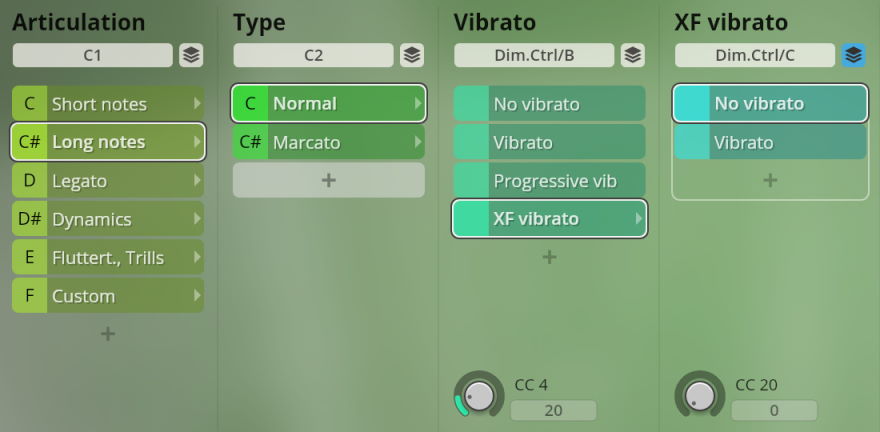
Marcato
If marcato is selected, keystroke velocity on Dim.Ctrl/A determines the marcato amount of the note played.
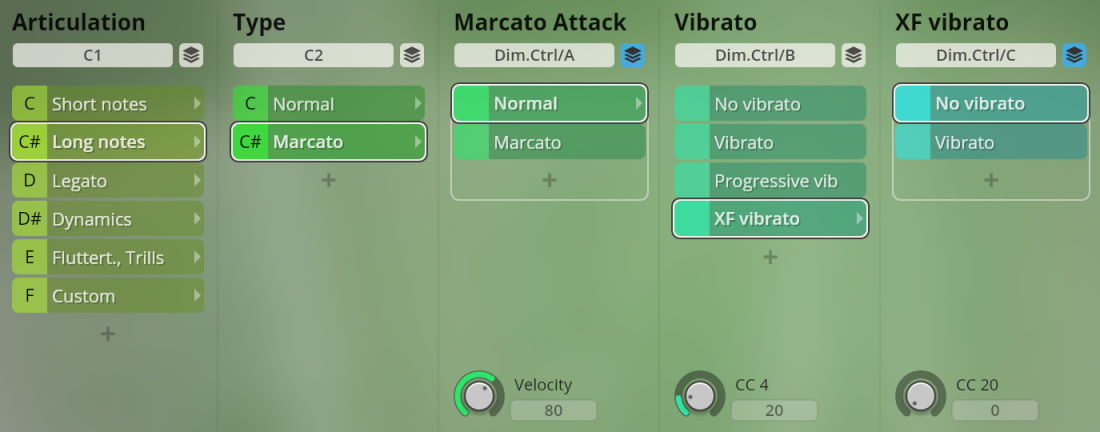
Legato
Performance legato, normal and fast, grace notes, and marcato.
The Auto-speed option implements a speed controller on Dim.Ctrl/D to switch automatically between normal and fast legato.
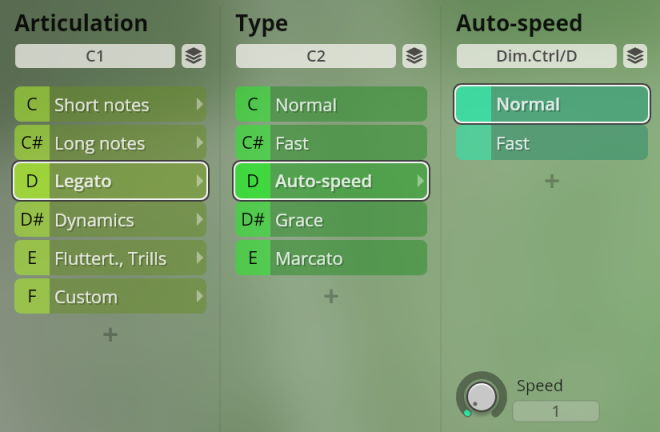
Dynamics
Sforzato, fortepiano, sforzatissimo; crescendo and diminuendo 2/3/5 sec., and piano-forte-piano 3/5/8 sec.
- Duration switches: G#2–A#2
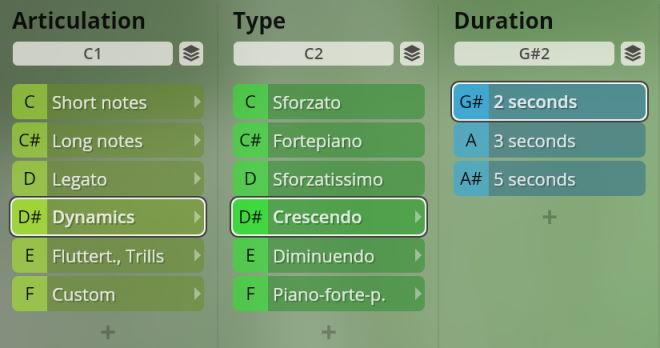
Flutter tonguing and trills
Flutter tonguing, normal and crescendo; half and whole tone trills.
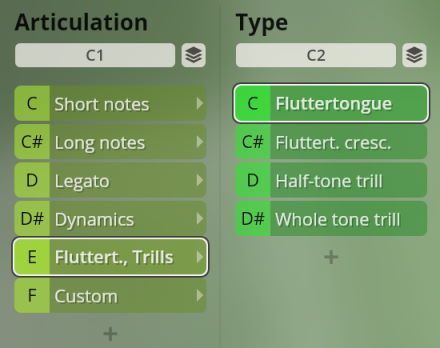
Bass flute
- Articulation switches: C1–F1.
- Type switches: starting at C2.
Short notes
Staccato, short and medium portato, as well as legato, portato, and staccato repetitions.
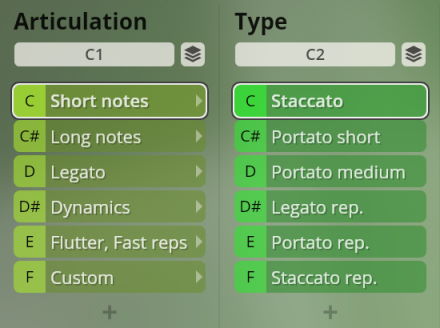
Long notes
Sustained notes, normal and marcato, without and with vibrato.
Use Dim.Ctrl/B (CC4) to switch between vibrato styles and the vibrato crossfade option, and Dim.Ctrl/C (CC20) to control the crossfade amount.
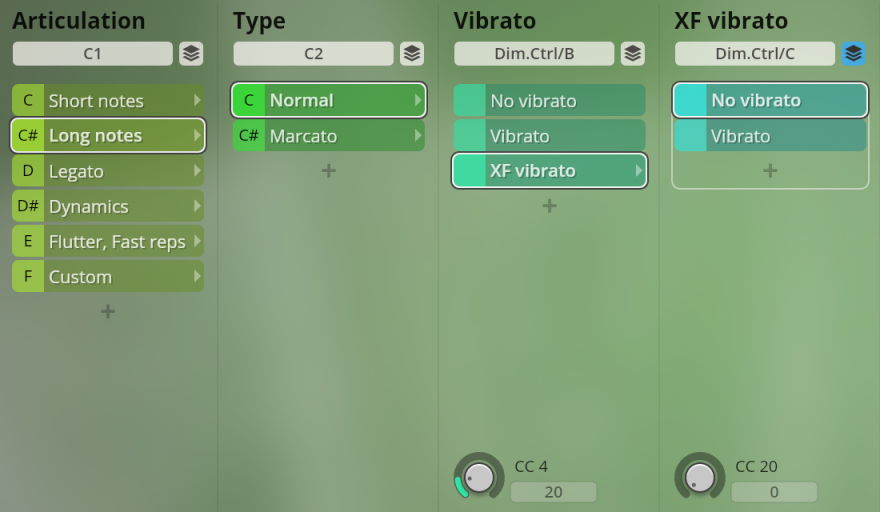
Marcato
If marcato is selected, keystroke velocity on Dim.Ctrl/A determines the marcato amount of the note played.
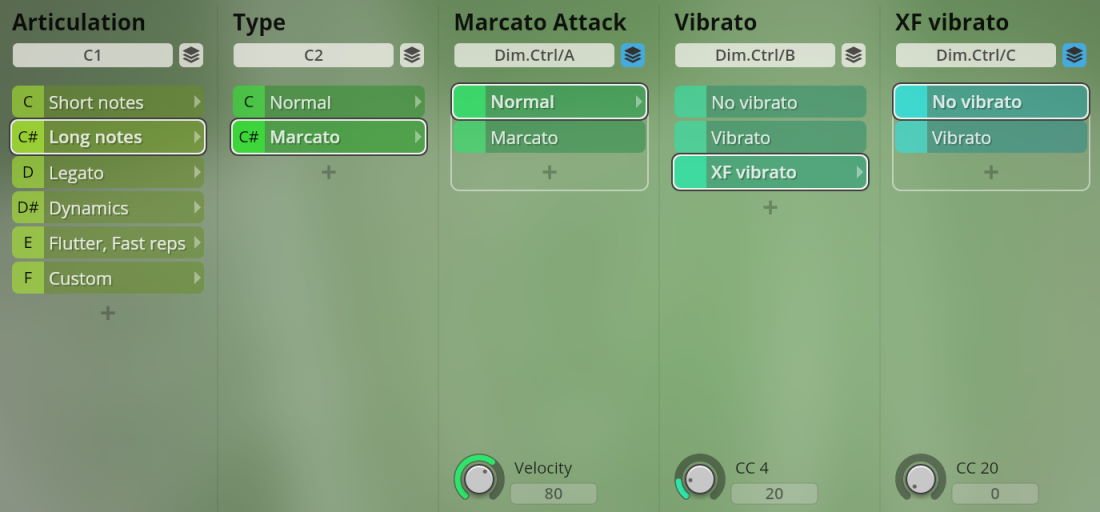
Legato
Performance legato, normal, fast, and marcato.
The Auto-speed option implements a speed controller on Dim.Ctrl/D to switch automatically between normal and fast legato.
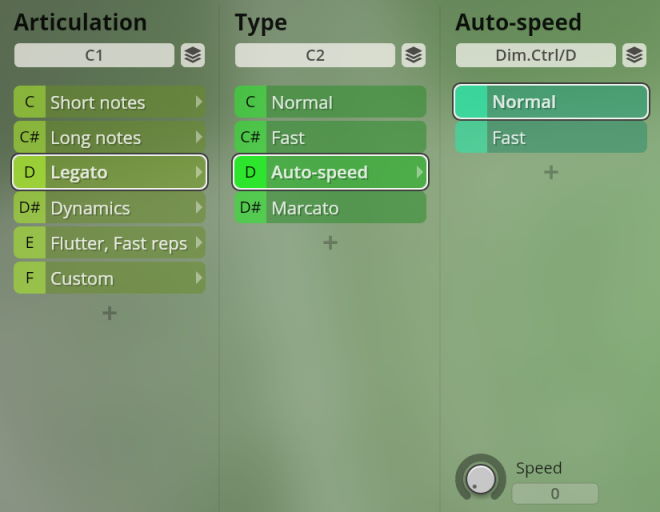
Dynamics
Sforzato, fortepiano, sforzatissimo with and without vibrato; strong crescendo and diminuendo 1.5/2/3/4 sec.; medium crescendo and diminuendo1.5/2/4 sec.; and piano-forte-piano with and without vibrato, 2/3/4/6 sec.
- Duration switches: G#6–B6
Sforzato, fortepiano, sforzatissimo
Use Dim.Ctrl/B (CC4) to switch between vibrato styles and the vibrato crossfade option, and Dim.Ctrl/C (CC20) to control the crossfade amount.
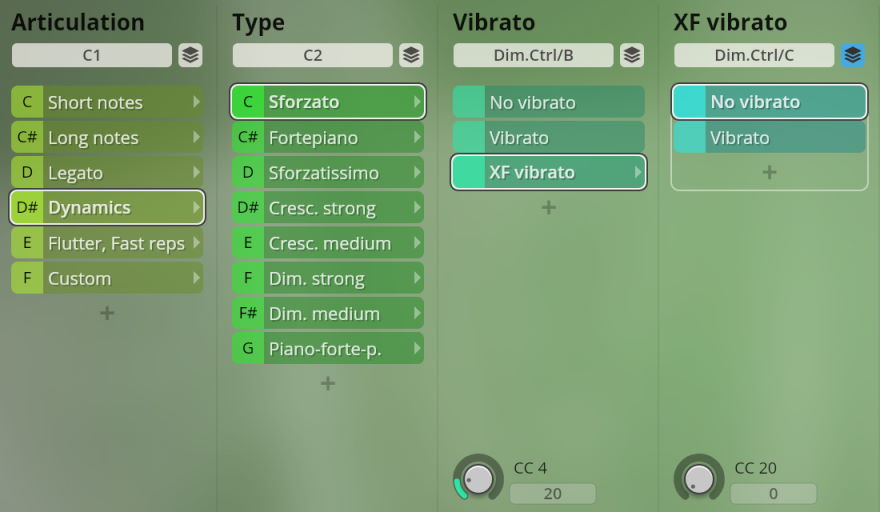
Strong crescendo and diminuendo
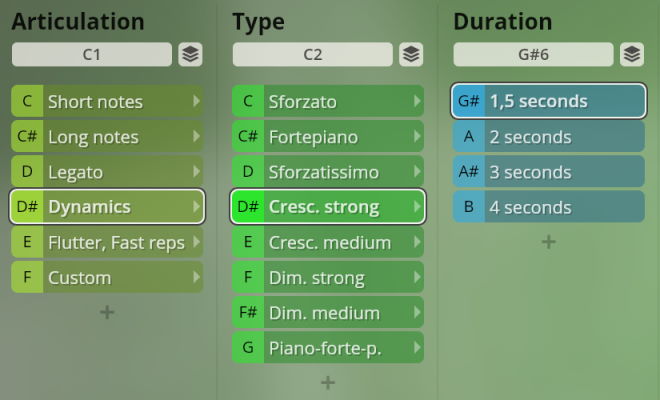
Medium crescendo and diminuendo, piano-forte-piano
Use Dim.Ctrl/B (CC4) to switch between vibrato styles and the vibrato crossfade option, and Dim.Ctrl/C (CC20) to control the crossfade amount.

Flutter tonguing and fast repetitions
Flutter tonguing, normal and crescendo; fast repetitions between 120 and 180 BPM.
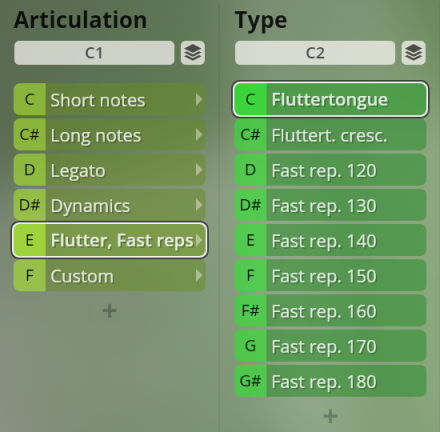
Oboe d’amore
- Articulation switches: C1–F1
- Type switches: starting at C2
Short notes
Staccato, short and medium portato, as well as legato, portato, and staccato repetitions.
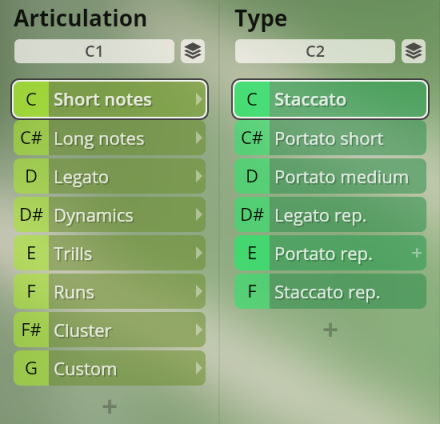
Long notes
Sustained notes, normal and marcato, without and with vibrato.
Use Dim.Ctrl/B (CC4) to switch between vibrato styles and the vibrato crossfade option, and Dim.Ctrl/C (CC20) to control the crossfade amount.
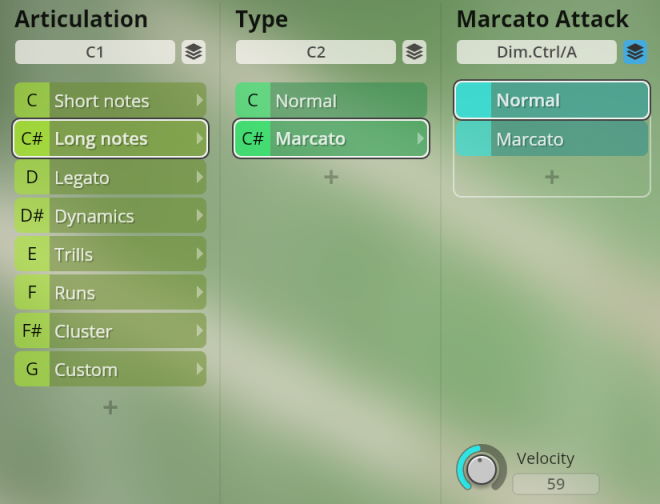
Marcato
If marcato is selected, keystroke velocity on Dim.Ctrl/A determines the marcato amount of the note played.
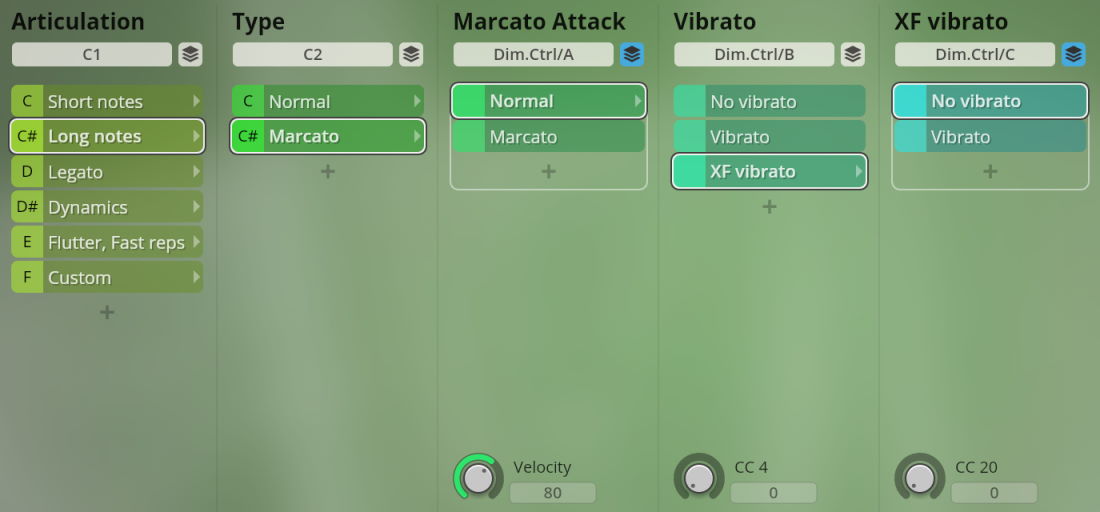
Legato
Performance legato, normal, fast, and marcato.
The Auto-speed option implements a speed controller on Dim.Ctrl/D to switch automatically between normal and fast legato.

Dynamics
Sforzato, fortepiano, sforzatissimo; strong crescendo and diminuendo 3/4 sec.; medium crescendo and diminuendo1.5/2/3/4 sec.; and piano-forte-piano 2/3/4 sec. All articulations with and without vibrato.
Sforzato, fortepiano, sforzatissimo
Use Dim.Ctrl/B (CC4) to switch between vibrato styles and the vibrato crossfade option, and Dim.Ctrl/C (CC20) to control the crossfade amount.
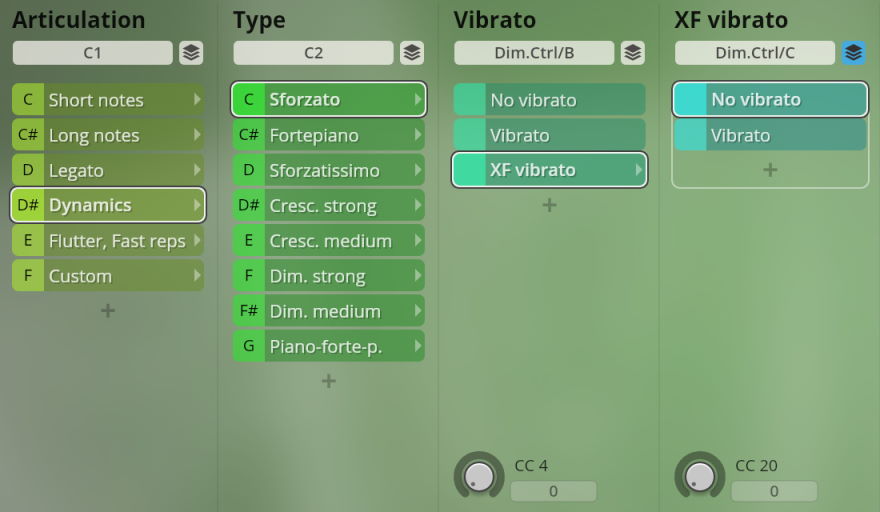
Crescendo and diminuendo, piano-forte-piano
Use Dim.Ctrl/B (CC4) to switch between vibrato styles and the vibrato crossfade option, and Dim.Ctrl/C (CC20) to control the crossfade amount.
- Duration switches: starting at A#2; piano-forte-piano: A2/B2 (white keys)
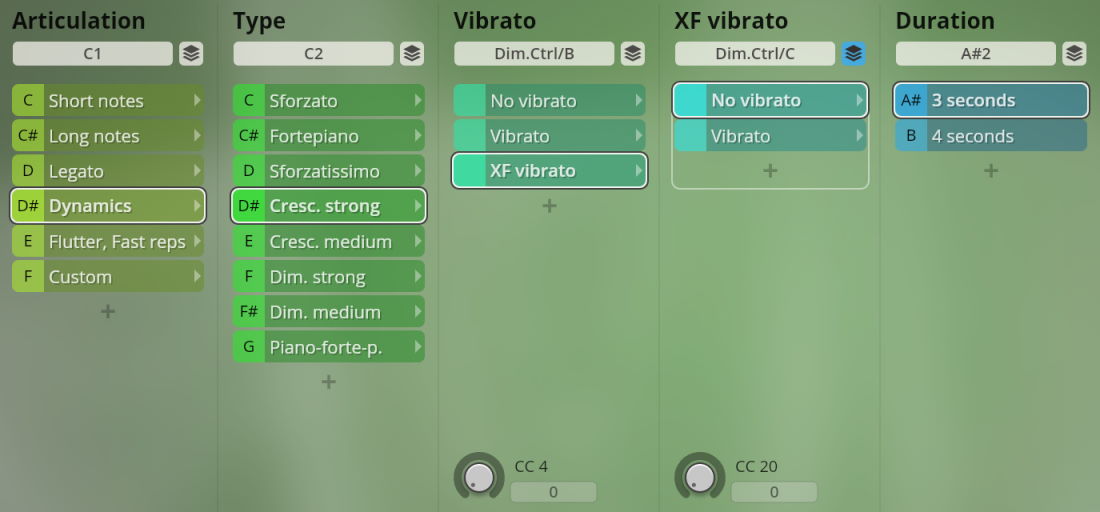
Flutter tonguing and fast repetitions
Flutter tonguing, normal and crescendo; fast repetitions between 120 and 180 BPM.
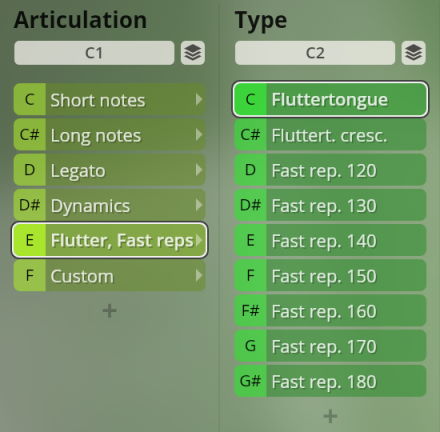
01 Heckelphone
- Articulation switches: C1–F1
- Type switches: starting at C2
Short notes
Staccato, short portato and medium portato, as well as legato, portato, and staccato repetitions.
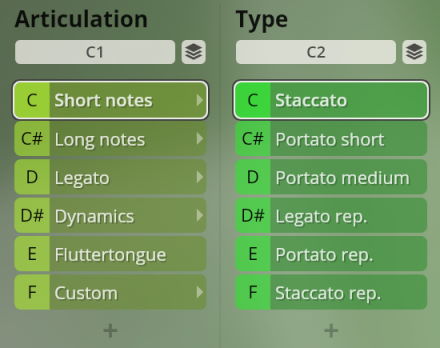
Long notes
Sustained notes, normal and marcato, with and without vibrato.
Use Dim.Ctrl/B (CC4) to switch between vibrato styles and the vibrato crossfade option, and Dim.Ctrl/C (CC20) to control the crossfade amount.
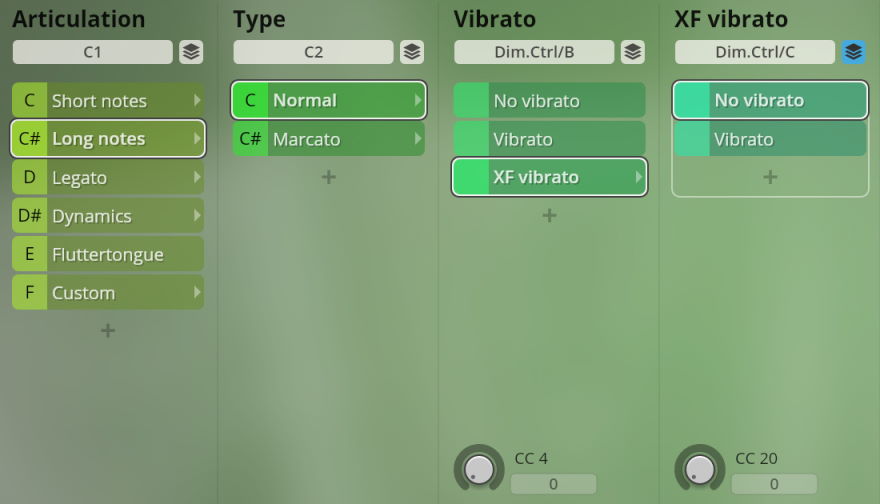
Marcato
If marcato is selected, keystroke velocity on Dim.Ctrl/A determines the marcato amount of the note played.
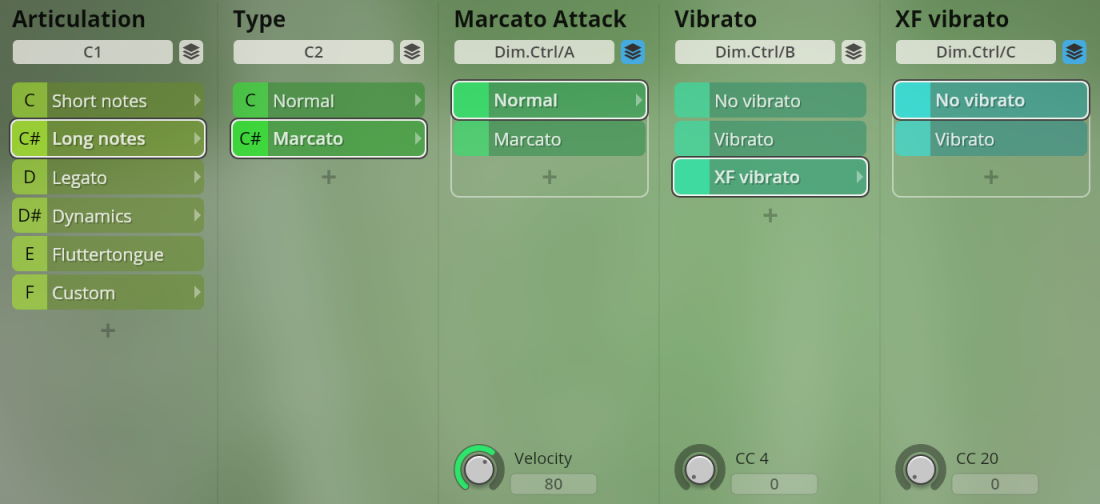
Legato
Performance legato, normal, fast, and marcato.
The Auto-speed option implements a speed controller on Dim.Ctrl/D to switch automatically between normal and fast legato.
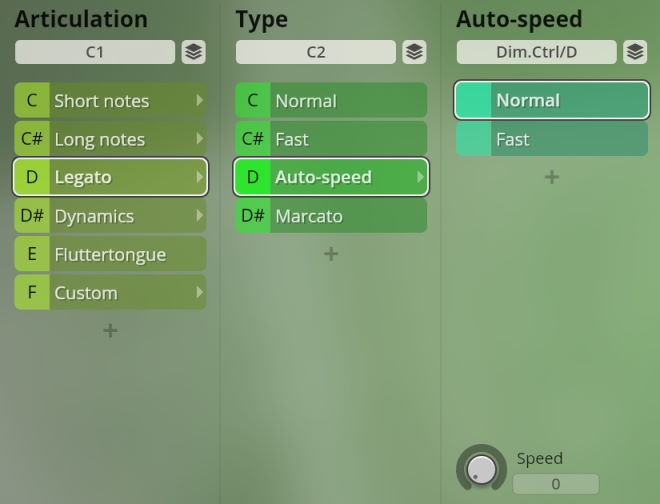
Dynamics
Sforzato, fortepiano, sforzatissimo; strong crescendo and diminuendo without vibrato, 1.5/2/3/4/6 sec.; medium crescendo and diminuendo with vibrato, 1.5/2/3/5 sec.; and piano-forte-piano 2/3/5/8 sec.
- Duration switches: strong G#6–C7; medium G#6–B6; pfp A6–C7
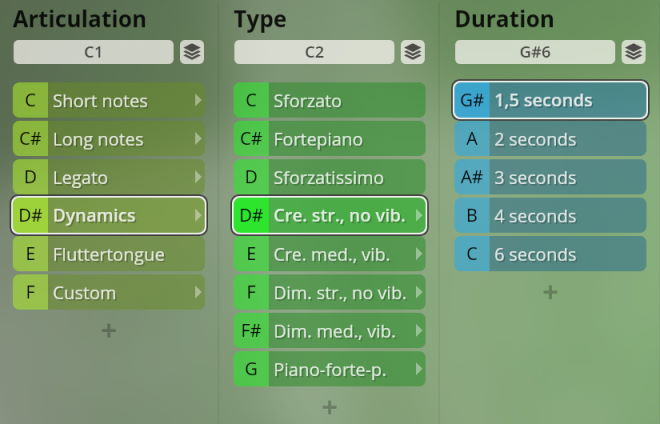
Flutter tonguing
There are no other options to this articulation.
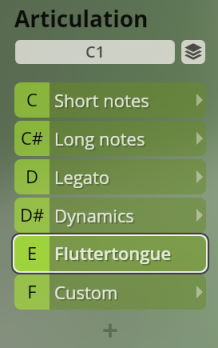
Small clarinet in Eb
- Articulation switches: C1–F1
- Type switches: starting at C2
Short notes
Staccato, short, medium, and long portato, as well as legato, portato, and staccato repetitions.
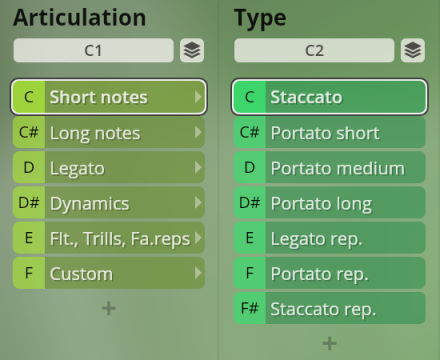
Long notes
Sustained notes, normal and with marcato attack.
If marcato is selected, keystroke velocity on Dim.Ctrl/A determines the marcato amount of the note played.
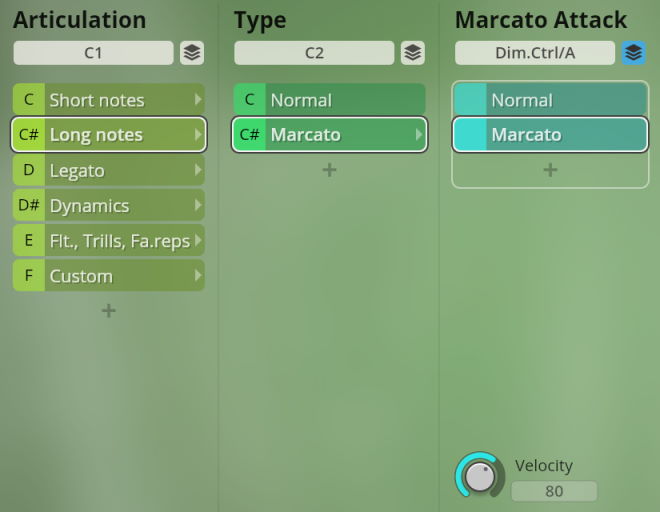
Legato
Performance legato, normal and fast, grace notes, and marcato.
The Auto-speed option implements a speed controller on Dim.Ctrl/D to switch automatically between normal and fast legato.

Dynamics
Sforzato, fortepiano, sforzatissimo; strong crescendo and diminuendo 2/3/4/6 sec., medium crescendo and diminuendo 1.5/2/3/4 sec., and piano-forte-piano 2/3/4/6/8 sec.
- Duration switches: strong cres/dim A2–C3; medium cres/dim G#2–B2; pfp A2–C#3
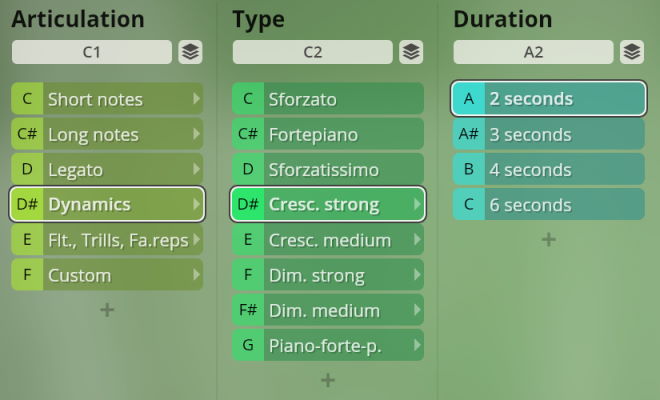
Flutter tonguing, trills, fast repetitions
Flutter tonguing, normal and crescendo; half and whole tone trills; fast repetitions between 140 and 180 BPM.
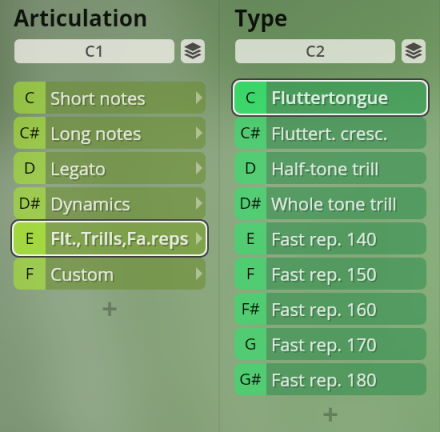
Basset horn
- Articulation switches: C1–F1
- Type switches: starting at C7
Short notes
Staccato, short and medium portato, as well as legato, portato, and staccato repetitions.
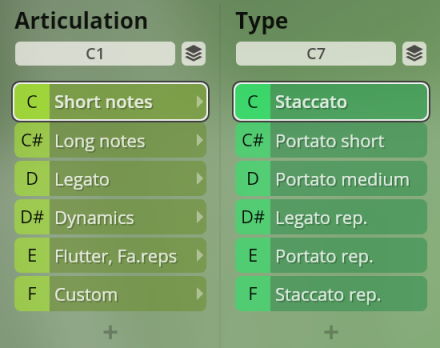
Long notes
Sustained notes, normal, marcato, and with soft attack.
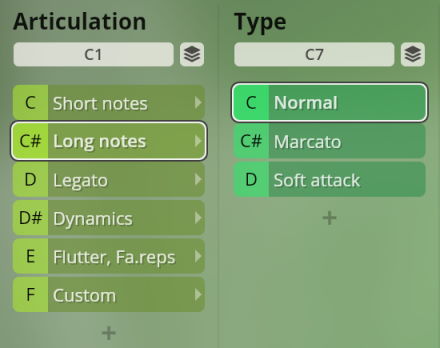
Legato
Performance legato, normal, fast, and marcato.
The Auto-speed option implements a speed controller on Dim.Ctrl/D to switch automatically between normal and fast legato.
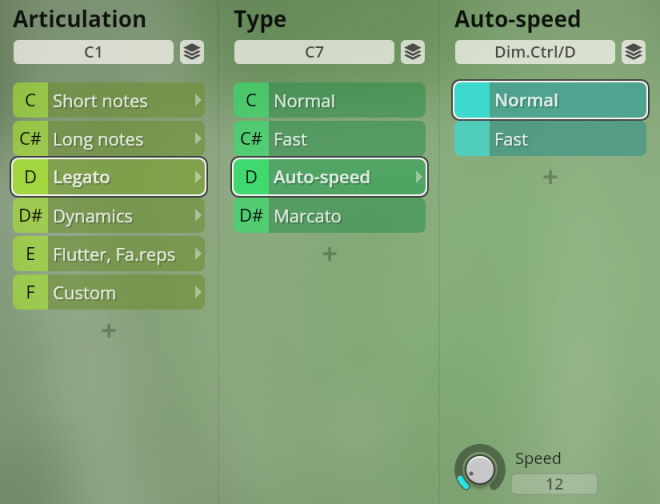
Dynamics
Sforzato, fortepiano, sforzatissimo; strong crescendo and diminuendo 1.5/2/3/4/6 sec., medium crescendo and diminuendo 1.5/2/3/4 sec., and piano-forte-piano 2/3/4/6/8 sec.
- Duration switches: G#7–B7/C8
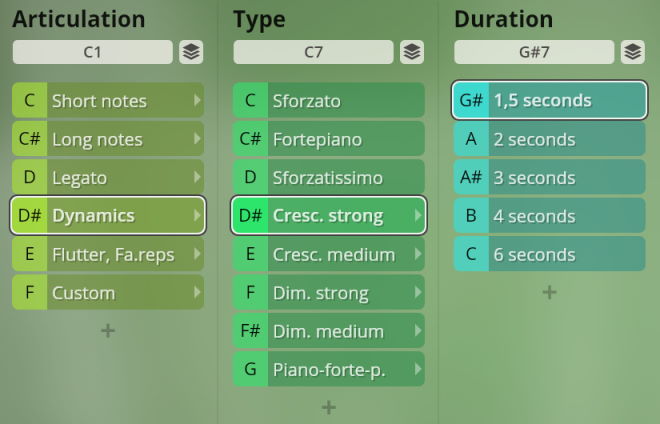
Flutter tonguing, fast repetitions
Flutter tonguing, normal and crescendo; fast repetitions between 120 and 180 BPM.
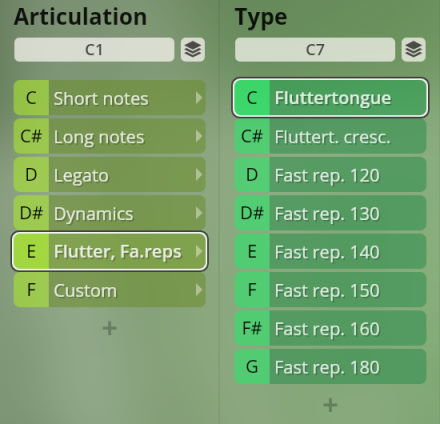
Contrabass clarinet
- Articulation switches: C6–F6
- Type switches: starting at C7
Short notes
Staccato and portato, as well as legato, portato, and staccato repetitions.
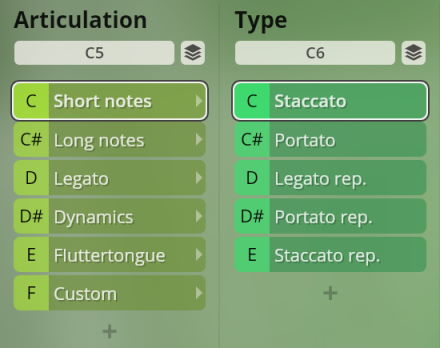
Long notes
Sustained notes, normal and with marcato attack.
If marcato is selected, keystroke velocity on Dim.Ctrl/A determines the marcato amount of the note played.
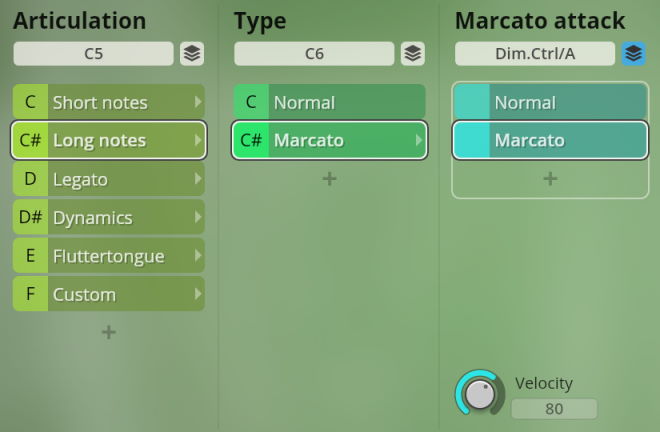
Legato
Performance legato, normal, fast, and marcato.
The Auto-speed option implements a speed controller on Dim.Ctrl/D to switch automatically between normal and fast legato.
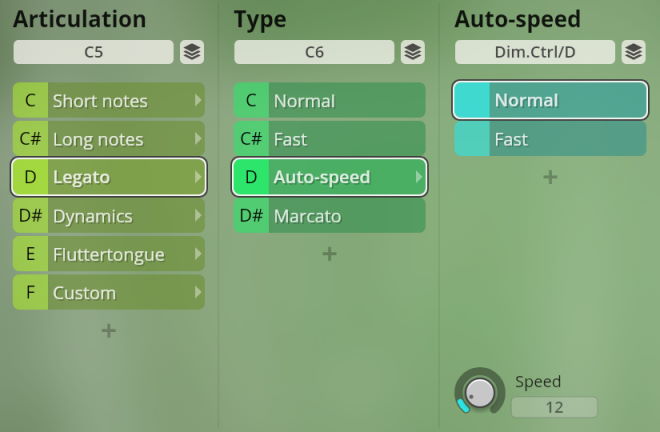
Dynamics
Sforzato, fortepiano, sforzatissimo; crescendo and diminuendo, 1.5/2/3/4/6 sec., and piano-forte-piano 2/3/4/6/8 sec.
- Duration switches: cres/dim G#6–C7; pfp A6–C#7
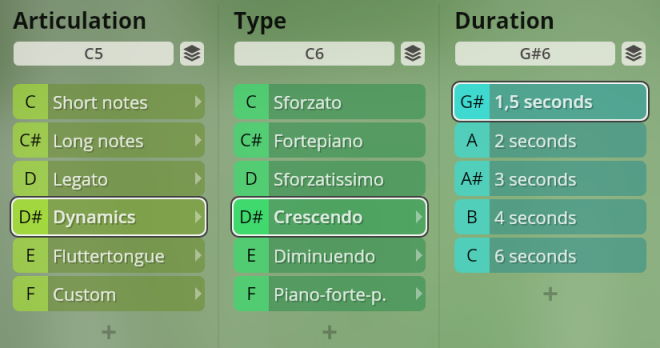
Flutter tonguing
Flutter tonguing, normal and crescendo.
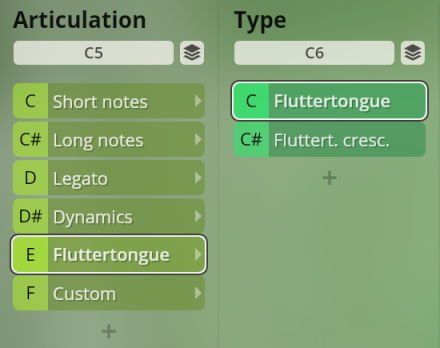
Ensembles: Flute, Clarinet, Oboe, Bassoon
Each of these ensembles consists of three players.
- Articulation switches: starting at C1
- Type switches: flute and oboe ensemble starting at C2; bassoon ensemble starting at C6
Short notes
Staccato, short and medium portato, as well as legato, portato, and staccato repetitions.

Long notes
Sustained notes, normal and marcato.
If marcato is selected, keystroke velocity on Dim.Ctrl/A determines the marcato amount of the note played.

Legato
Performance legato, normal, fast, and marcato.
The Auto-speed option implements a speed controller on Dim.Ctrl/D to switch automatically between normal and fast legato.
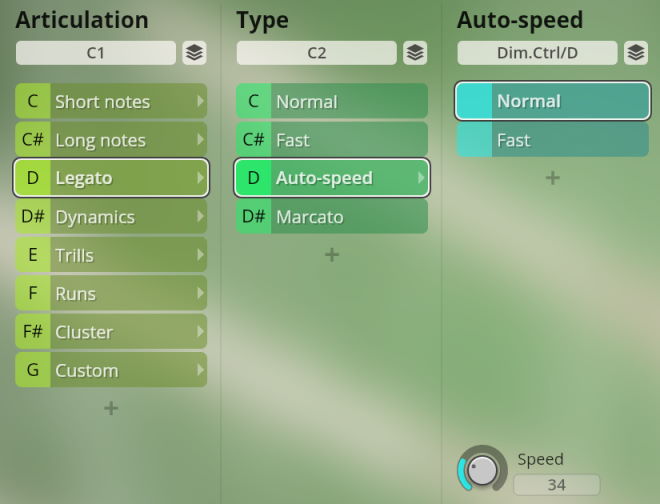
Dynamics
Sforzato, fortepiano, sforzatissimo; crescendo and diminuendo 2/3/5 sec.
- Duration switches: G#2–A#2
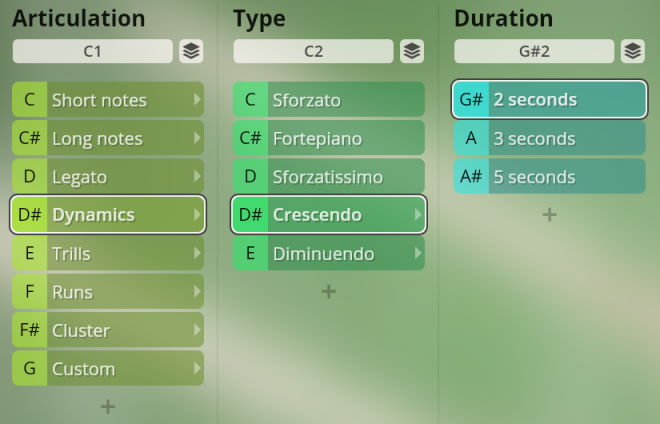
Trills
Half and whole tone trills.
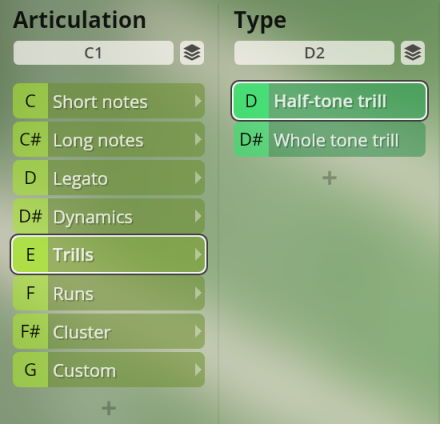
Runs (Flute ensemble only)
Octave runs, up and down, chromatic and whole tone.
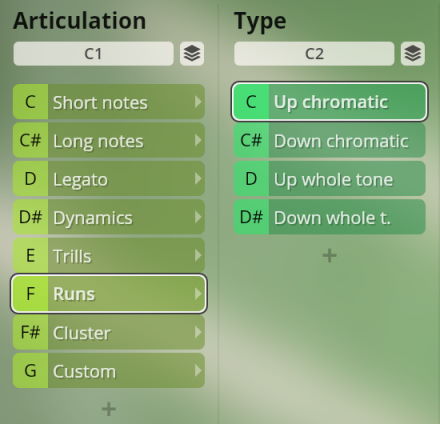
Clusters
Three-note clusters, normal and sforzato.
